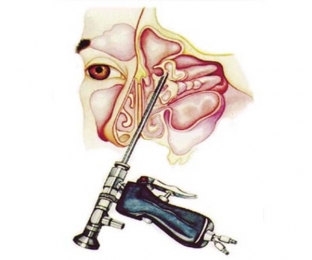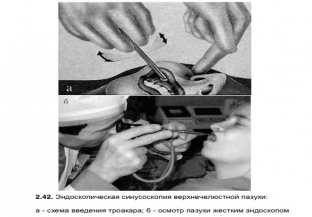Modern medicine is confidently and actively moving forward, finding new methods for diagnosing and treating various diseases. Today, in their daily practice, doctors use & nbsp; methods that only a few decades ago were perceived as something from the realm of fantasy. One of these methods is diagnostic endoscopy of the nose – a research method that has significantly improved the quality of medical care in otorhinolaryngology. Given the structural features of the nose and paranasal sinuses, nasal endoscopy is the only procedure that allows you to visualize and assess the condition of the most inaccessible areas of the nose, nasopharynx and paranasal sinuses. The methodology for performing diagnostic nasal endoscopy will be discussed further.
Indications for diagnostic nasal endoscopy
The goal of diagnostic nasal endoscopy is to identify the symptoms of nasal and paranasal pathology as early as possible in order to initiate effective treatment using minimally invasive surgery and to limit damage to the anatomical structures of the nasal cavity as much as possible.
There are the following indications for diagnostic nasal endoscopy:
- any nasal breathing disorder;
- disturbances in the olfactory function of the nose;
- nasal discharge;
- recurrent nosebleeds;
- suspicion of neoplasms of the nasal cavity;
- inflammatory diseases of the nose and paranasal sinuses;
- Estachian tube dysfunction;
- headaches of unknown etiology;
- preoperative examination and postoperative examination of the nasal cavity.
Technique for performing a diagnostic nasal endoscopy
Before starting the procedure of diagnostic nasal endoscopy, it is necessary to perform a toilet of the nasal cavity and, if necessary, application anesthesia. For diagnostic purposes, a rigid endoscope with zero optics is most often used. The nasal endoscopy procedure takes place in three stages:
- At the first stage, a general panoramic view of the vestibule of the nose and the common nasal passage is made. After that, the endoscope is advanced along the bottom of the nasal cavity to the nasopharynx, assessing the condition of the visible mucous membranes. With further advancement of the endoscope posteriorly, the presence of adenoid vegetations is clarified, the condition of the posterior ends of the inferior turbinate, the nasopharyngeal arch and the mouths of the auditory tubes is assessed.
- At the second stage of the study, the endoscope is advanced from the vestibule of the nose to the middle turbinate, where the condition of its mucous membrane and the middle nasal passage is examined.
- At the last stage, the superior nasal passage and olfactory fissure are examined, sometimes it is possible to visualize the superior nasal concha and the outlet openings of the cells of the ethmoid labyrinth.

Evaluation of the condition of the maxillary sinus using endoscopy
The condition of the maxillary sinus can also be assessed using diagnostic endoscopy. The indications for sinusoscopy are:
- clarification of the diagnosis in isolated lesions of the maxillary sinus;
- removal of foreign bodies;
- carrying out medical procedures.

Before performing a diagnostic endoscopy of the maxillary sinus, the patient is given local anesthesia, blocking the branches of the trigeminal nerve. Using a special trocar with a sleeve, the anterior wall of the maxillary sinus is drilled with rotational movements at the level between the roots of the 3rd and 4th teeth. Further, an endoscope with an optical system from 0 to 70° is inserted through the sleeve into the cavity of the maxillary sinus. and carefully examine the condition of the maxillary sinus. At the end of the examination, the trocar sleeve is removed by performing gentle rotational movements.
Advantages of nasal endoscopy over other diagnostic methods
Thus, diagnostic nasal endoscopy is a highly informative method for assessing the condition of the nose and paranasal sinuses. Given the invasiveness of the procedure, nasal endoscopy should only be performed by a highly qualified specialist with sufficient experience in performing this procedure. With the help of diagnostic endoscopy of the nose, it is possible to assess the condition of the most inaccessible parts of the nose and paranasal sinuses, decide on the subsequent medical tactics and immediately perform surgical intervention, if there are indications for it. Nasal endoscopy today can be called the most informative method for examining the nasal cavity and sinuses.







Add a comment